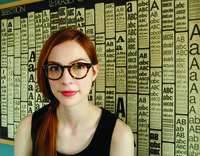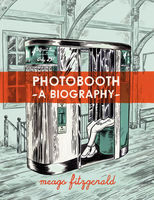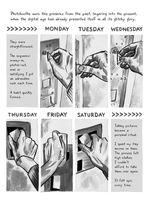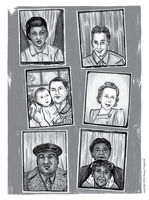Guttersnipes: Meags Fitzgerald
By Evan Munday
TCAF is the Toronto Comic Arts Festival. It is an annual week-long celebration of comics and graphic novels and their creators, featuring readings, interviews, panels, workshops, gallery shows, art installations, and culminating in a two-day exhibition and vendor fair featuring hundreds of comics creators from around the world. The Toronto Comic Arts Festival 2014 will take place Saturday, May 10 and Sunday May 11, at Toronto Reference Library (789 Yonge Street). Admission is free. Leading up to the Festival, I'll be interviewing some of the dazzling comic writers and illustrators – particularly the Canadian ones – who have brand-new books out for TCAF.
Meags Fitzgeraldis an artist and storyteller who draws, animates, writes, and performs. Photobooth: A Biography is her first graphic novel. In it, Fitzgerald chronicles the photobooth's history and the events that gave rise to the desperate need to save them. Having traveled in North America, Europe, and Australia, she's constructed a biography of the booth through the eyes of technicians, owners, collectors, artists, and fanatics.
Please describe, as best you can, your new comic book as an equation of movies. (e.g. Passenger 57 + Fried Green Tomatoes – unintentional cannibalism)
Amélie + Lost in Translation+ PBS's 'Antiques Roadshow.'
What was your favourite comic book when you were thirteen?
At thirteen I was pretty much only reading Sailor Moon manga. We all start somewhere.
What was the name and general premise of the first book you ever made? (That is, when you were a kid, making stories for your siblings and/or friends?)
The first story that I was very serious about was a rewrite of The Little Match Girl. In Grade 3, we read the Hans Christian Andersen story before Christmas and I was horrified by the ending. (Spoiler: she dies.) In my version, just as the Little Match Girl is about to freeze to death in a snowbank, a very rich woman finds her, adopts her, raises her alongside her own children and in the end the Little Match Girl marries her adoptive brother and they all live happily ever after.
Have you been to TCAF before? If so, what’s your favourite TCAF memory? If not, what are you most looking forward to?
Yes, last year was the first year I was able to attend and I had an extraordinary time! My favourite memory was attending the Doug Wright Awards. All the camaraderie and talent in the room made my heart grow three sizes.
Your CanLit News
Subscribe to Open Book’s newsletter to get local book events, literary content, writing tips, and more in your inbox
If you could collaborate with one other TCAF guest, who would it be (and why)?
Just one!? If I have to narrow it down, I’d love to collaborate with some Québécois artists. To name a few, I really admire the work of Isabelle Arsenault, Pascal Girard, and Michel Rabagliati. There's a je ne sais quoi to Québécois storytelling. As for publishers, my soul would explode out of my body for a chance to illustrate for Nobrow.
What do you find the most difficult thing to write? Draw?
I've got two versions of this answer:
1.) The hardest part of writing history comics is when you need to relay didactic info, like a handful of dates and small details. It's a challenge to keep those parts engaging, lively and succinct.
2.) The hardest thing to write is the very personal material. I had an emotional tug of war over how much or how little to include about my personal life and relationships in the book.
TCAF is now over ten years old. What's the biggest change you've noticed in the world of comics in the past ten years?
While working on the book, I was pleasantly surprised that I almost never had to explain what a graphic novel was to anyone. I conducted a lot of interviews in the photobooth industry and no one questioned why I was using comics as the medium for journalistic and historical material. I don't think that would have been the case ten years ago.
Given that your new book looks at the life and decline of photobooths, can you describe your first experience with a photobooth?
My first few memories of using a photobooth are the same as anyone's – in a shopping mall with friends, crammed into the small space, posing for silly photos. My experience is perhaps only notable in that I really liked it. Not long after, I was using a photobooth nearly every day after school, both as a creative outlet and as a teen-angst coping strategy. That was eleven years and 7,000 photobooth pictures ago.
There are few examples of cultural histories (which Photobooth: A Biography is, largely) in comic book form. Are there any other cultural artifacts or touchstones you'd like to explore in a similar fashion?
Yes, I have two other book ideas that are both personal and historical, however, unlike Photobooth: A Biography, they aren't about one specific cultural artifact but rather, universal concepts. I'm keeping the ideas a secret for now… perhaps by TCAF 2016, you will know.
While the permanent photobooth has somewhat disappeared from the city landscape, temporary photobooths are becoming more prominent at things like weddings and corporate events. How do you feel about these pop-up photobooths?
I'm glad you asked. I hate them.
Okay, that's not quite true. Like anyone else, I think they're fun at parties but I wish people didn't call these pop-up photo stations 'photobooths.' The popularity of these event-based photo stations made my research nightmarish. (Google results for 'photobooths' are overrun by digital rental services and wedding blogs.) Photobooth: A Biography is largely about the world before the digital era and before the word 'selfie' was coined. The parts of the book that are set in present day focus on a small international community that has banded together to preserve and promote what are left of the old chemical photobooths.
Visit torontocomics.com to find out more about TCAF and Meags Fitzgerald's appearance at the festival.
The views expressed in the Writer-in-Residence blogs are those held by the authors and do not necessarily reflect the views of Open Book: Toronto.
The views expressed in the Writer-in-Residence blogs are those held by the authors and do not necessarily reflect the views of Open Book.
Evan Munday is the author and illustrator of the acclaimed book series for young readers, The Dead Kid Detective Agency. Both The Dead Kid Detective Agencyand its sequel, Dial M for Morna, were nominated for the Silver Birch Fiction Award.
Evan has worked in book marketing and publicity for ten years, eight of which were as publicist at Coach House Books, and he has since worked as a freelance illustrator and ebook designer.
Find out more about Evan on his website, idontlikemundays.com or follow him on Twitter at @idontlikemunday.






